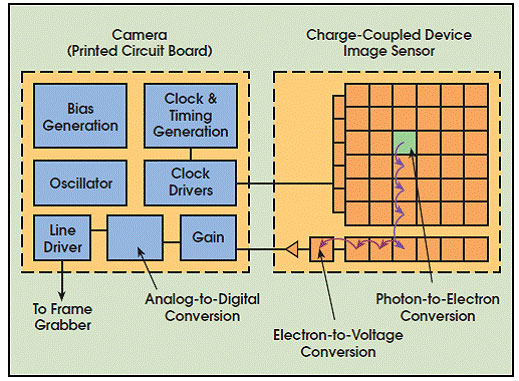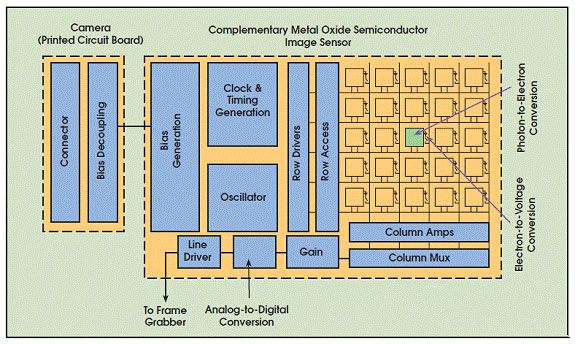CCD (charge coupled device) and CMOS (complementary metal oxide semiconductor) image sensors are
two different technologies for capturing images digitally. Each has unique strengths and weaknesses,
giving advantages in different applications. Neither is categorically superior to the other. In the
last five years much has changed with both technologies, and the outlook for both technologies is vibrant.
Both types of imagers convert light into electric charge and process it into electronic signals. In a CCD sensor, every pixel's charge is transferred through a very limited number of output nodes to be converted to voltage, buffered, and sent off chip as an analog signal. In a CMOS sensor, each pixel has its own charge-to-voltage conversion, and the sensor often also includes amplifiers, noise correction, and digitization circuits, so that chip outputs are digital bits. See figures 1 & 2.

Figure 1: Diagram of a CCD.
On a CCD, most functions take place on the camera's printed circuit board. If the application's demands change, a designer can change the electronics without redesigning the imager.

Figure 2: Diagram of a CMOS.
A CMOS imager converts charge to voltage at the pixel, and most functions are integrated into the chip.
This makes imager functions less flexible but, for applications in rugged environments, a CMOS camera can
be more reliable.
This difference in readout techniques has significant implications for sensor capabilities and limitations.
Eight attributes characterize image sensor performance.
Responsivity, the amount of signal the sensor delivers per unit of input optical energy. CMOS imagers
are marginally superior to CCDs.
Dynamic range, the ratio of a pixel's saturation level to its signal threshold. CCDs have the advantage here.
Uniformity, is the consistency of response for different pixels under identical illumination conditions.
CMOS imagers were traditionally much worse than CCDs, however new amplifiers have made the illuminated uniformity of
some CMOS imagers close to that of CCDs.
Shuttering, the ability to start and stop exposure arbitrarly, is superior in CCD devices. CMOS devices
require extra transistors or nonuniform shuttering, sometimes called rolling shuttering to achieve the same results.
Speed, an area in which CMOS arguably has the advantage over CCDs because all of the camera functions can be
placed on the image sensor.
Windowing, CMOS technology has the ability to read out a portion of the image sensor allowing elevated frame
rates for small regions of interest. CCDs generally have limited abilities in windowing.
Antiblooming, is the ability to gracefully drain localized overexposure without compromising the rest of the
image in the sensor. CMOS generally has natural blooming immunity. CCDs require specific engineering to achieve this capability.
Biasing and clocking. CMOS imagers have a clear advantage in the area, operating on a single bias voltage and clock level.
CCD and CMOS imagers were both invented in the late 1960's. CCD became dominant in the market, primarily because they produced superior images with the fabrication technology available. CMOS image sensors required more uniformity and smaller features than silicon wafer foundries could deliver at the time. Not until the 1990's, with the development of lithography was there a renewed interest in CMOS. That interest is due to lower power consumption, camera-on-a-chip integration, and lowered fabrication costs. Both CCD and CMOS imagers offer excellent imaging performance. CMOS imagers offer more integration (more functions on the chip), lower power dissipation (at the chip level), and the possibility of smaller system size.
Today there is no clear line dividing the types of applications each can serve. CCD and CMOS technologies are used interchangeably. CMOS designers have devoted intense effort to achieving high image quality, while CCD designers have lowered their power requirements and their pixel sizes. As a result, you can find CMOS sensors in high-performance professional and industrial cameras and CCDs in low cost low power cell phone cameras. For the moment, CCDs and CMOS remain complementary technologies-one can do things uniquely the other cannot. Over time this distinction will soften, with more CMOS imagers consuming more and more of the CCD's traditional applications. Considering the relative strength and opportunities of CCD and CMOS imagers, the choice continues to depend on the application and the vendor more than the technology.
References:
http://www.dalsa.com/corp/markets/CCD_vs_CMOS.aspx
http://www.dalsa.com/shared/content/Photonics_Spectra_CCDvsCMOS_Litwiller.pdf